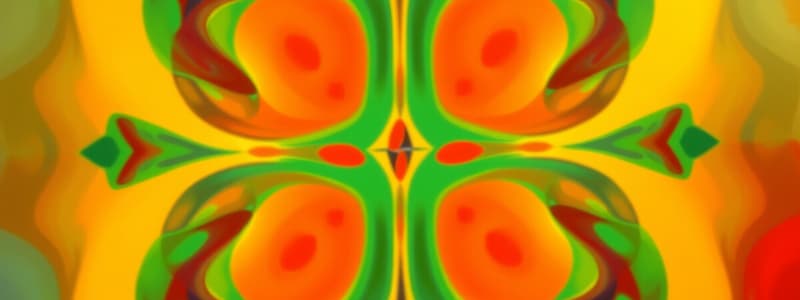Podcast
Questions and Answers
Match the following entities with their descriptions:
Match the following entities with their descriptions:
Trees = Natural objects found in the environment Monkeys = Primates often found in the wild Rocks = Solid mineral material Planets = Celestial bodies orbiting a star
Match the following phrases about perception with their correct meanings:
Match the following phrases about perception with their correct meanings:
Seeing the world through your eyes = Experiencing reality as interpreted by senses Annotated world on a screen = Visual representation with additional information Recognizing things on the screen = Identifying objects in a digital format Solving nothing = Addressing a problem without providing a solution
Match the following statements with their implications about AI perception:
Match the following statements with their implications about AI perception:
Machines getting better = Ongoing improvements in technology No machine can compare = Current limitations in AI capabilities Future advancements expected = Predictions about AI's potential evolution Graduate student's unfinished project = Challenges faced in achieving object recognition
Match the following descriptions to their subjects in the context of object recognition:
Match the following descriptions to their subjects in the context of object recognition:
Match the following concepts related to language and perception:
Match the following concepts related to language and perception:
Match the following illusions with their respective explanations:
Match the following illusions with their respective explanations:
Match the following psychological concepts with their descriptions:
Match the following psychological concepts with their descriptions:
Match the following types of perception with their characteristics:
Match the following types of perception with their characteristics:
Match the following aspects of perception with their examples:
Match the following aspects of perception with their examples:
Match the following terms with their related aspects in cognitive psychology:
Match the following terms with their related aspects in cognitive psychology:
Match the following outcomes with their corresponding concepts:
Match the following outcomes with their corresponding concepts:
Match the following terms with their definitions:
Match the following terms with their definitions:
Match the concepts with their explanations related to vision:
Match the concepts with their explanations related to vision:
Match the examples with their related concepts:
Match the examples with their related concepts:
Match the Gestalt principles with their effects:
Match the Gestalt principles with their effects:
Match the types of perception with their challenges:
Match the types of perception with their challenges:
Match the color illusions with their outcomes:
Match the color illusions with their outcomes:
Match the visual concepts with their descriptions:
Match the visual concepts with their descriptions:
Match the visual perception struggles with their examples:
Match the visual perception struggles with their examples:
Match the visual phenomena with their implications:
Match the visual phenomena with their implications:
Match the principles with their corresponding visual tasks:
Match the principles with their corresponding visual tasks:
Match the visual experiences with their characteristics:
Match the visual experiences with their characteristics:
Match the optical illusions with their examples:
Match the optical illusions with their examples:
Match the types of cues with their associated perception challenges:
Match the types of cues with their associated perception challenges:
Match the perception adjustments with their triggers:
Match the perception adjustments with their triggers:
Match the visual perception principles with their descriptions:
Match the visual perception principles with their descriptions:
Match the optical illusions with their explanations:
Match the optical illusions with their explanations:
Match the depth perception cues with their definitions:
Match the depth perception cues with their definitions:
Match the illusions with the objects depicted:
Match the illusions with the objects depicted:
Match the principle to its example:
Match the principle to its example:
Match the depth cues with their applications:
Match the depth cues with their applications:
Match the visual elements with their effects:
Match the visual elements with their effects:
Match the visual grouping principles with their explanations:
Match the visual grouping principles with their explanations:
Match the types of illusions with their origins:
Match the types of illusions with their origins:
Match the dynamic cues to their characteristics:
Match the dynamic cues to their characteristics:
Match the terms with their relevance in perception:
Match the terms with their relevance in perception:
Match the terms with their descriptions:
Match the terms with their descriptions:
Match the perception mechanisms to their roles:
Match the perception mechanisms to their roles:
Match the visual elements with their functions:
Match the visual elements with their functions:
Match the cognitive biases with examples:
Match the cognitive biases with examples:
What aspect of object recognition has proven to be particularly challenging in AI research according to historical anecdote?
What aspect of object recognition has proven to be particularly challenging in AI research according to historical anecdote?
What did the AI researcher assign to the graduate student as a summer project?
What did the AI researcher assign to the graduate student as a summer project?
How have machines progressed in regards to object recognition compared to humans?
How have machines progressed in regards to object recognition compared to humans?
What misconception about object perception is suggested in the content?
What misconception about object perception is suggested in the content?
What is the relationship between human perception and the project of object recognition in AI?
What is the relationship between human perception and the project of object recognition in AI?
Why might the depiction of perception in a film like Terminator be misleading?
Why might the depiction of perception in a film like Terminator be misleading?
What ongoing development have researchers been focusing on regarding object recognition?
What ongoing development have researchers been focusing on regarding object recognition?
What does the mention of the 'fleshy GUI' suggest in the context of perception?
What does the mention of the 'fleshy GUI' suggest in the context of perception?
What is the main reason individuals perceive the two Shepard tables as different sizes at first glance?
What is the main reason individuals perceive the two Shepard tables as different sizes at first glance?
How do the mechanisms of language and vision share similarities according to the discussion?
How do the mechanisms of language and vision share similarities according to the discussion?
Which statement best describes how individuals react to the phrase 'the pig is eager to eat' compared to 'the pig is easy to eat'?
Which statement best describes how individuals react to the phrase 'the pig is eager to eat' compared to 'the pig is easy to eat'?
What psychological principle is being highlighted by the discussion of the Shepard tables?
What psychological principle is being highlighted by the discussion of the Shepard tables?
What is suggested as a take-home exercise related to the Shepard tables?
What is suggested as a take-home exercise related to the Shepard tables?
In the context of perception, what role do cues play according to the provided content?
In the context of perception, what role do cues play according to the provided content?
What type of processing is described in the context of understanding both language and perception?
What type of processing is described in the context of understanding both language and perception?
Which of the following illusions is mentioned as a related concept to understanding depth perception?
Which of the following illusions is mentioned as a related concept to understanding depth perception?
What is one challenge of perceiving objects from the retina's input?
What is one challenge of perceiving objects from the retina's input?
How does the visual system compensate for shadows?
How does the visual system compensate for shadows?
What psychological principle explains why we perceive grouped objects together?
What psychological principle explains why we perceive grouped objects together?
What happens when the external cues for color perception are removed?
What happens when the external cues for color perception are removed?
Which factor does NOT influence our perception of brightness?
Which factor does NOT influence our perception of brightness?
How does the human brain interpret ambiguous shapes?
How does the human brain interpret ambiguous shapes?
What concept explains that several interpretations are possible for visual stimuli?
What concept explains that several interpretations are possible for visual stimuli?
What is a likely outcome when a surface appears darker due to shadow?
What is a likely outcome when a surface appears darker due to shadow?
What does firing intensity of neurons correspond to in terms of perception?
What does firing intensity of neurons correspond to in terms of perception?
Why might an object like the moon appear uncertain in distance?
Why might an object like the moon appear uncertain in distance?
What is the best explanation of the Gestalt principle of similarity?
What is the best explanation of the Gestalt principle of similarity?
What factor is least likely to affect our perception of an object's color?
What factor is least likely to affect our perception of an object's color?
What assumption does our brain make about objects in shadow?
What assumption does our brain make about objects in shadow?
What principle explains why we might see a circle and a square as two distinct objects even when they overlap?
What principle explains why we might see a circle and a square as two distinct objects even when they overlap?
Which principle is utilized when interpreting the simplest continuation of lines connecting two points?
Which principle is utilized when interpreting the simplest continuation of lines connecting two points?
What causes the perception of a light triangle in an illusion created by circular shapes like Pac-Man?
What causes the perception of a light triangle in an illusion created by circular shapes like Pac-Man?
How does interposition help determine the relative positions of objects?
How does interposition help determine the relative positions of objects?
What cue might lead to a misconception regarding the size of objects in an illusion, such as the Mueller Lyer illusion?
What cue might lead to a misconception regarding the size of objects in an illusion, such as the Mueller Lyer illusion?
Which depth cue involves understanding the relative size of an object in comparison to known dimensions?
Which depth cue involves understanding the relative size of an object in comparison to known dimensions?
What visual cue indicates that one object is closer than another by blocking it?
What visual cue indicates that one object is closer than another by blocking it?
What kind of illusion occurs when the configuration of lines leads to a misjudgment of length, as seen in the Ponzo illusion?
What kind of illusion occurs when the configuration of lines leads to a misjudgment of length, as seen in the Ponzo illusion?
What cognitive process allows us to perceive a complex shape as a simpler one, enhancing clarity in visual interpretation?
What cognitive process allows us to perceive a complex shape as a simpler one, enhancing clarity in visual interpretation?
In the context of depth perception, which method involves observing how objects change in appearance as distance varies?
In the context of depth perception, which method involves observing how objects change in appearance as distance varies?
What perceptual factor is indicated when two objects are grouped together based on visual similarity?
What perceptual factor is indicated when two objects are grouped together based on visual similarity?
Which of the following describes how the human brain interprets depth information from a flat image?
Which of the following describes how the human brain interprets depth information from a flat image?
What visual principle is at play when an arrangement of lines suggests an object’s edges, leading to an illusion of depth?
What visual principle is at play when an arrangement of lines suggests an object’s edges, leading to an illusion of depth?
Which perception mechanism helps in distinguishing between overlapping objects in visual scenes?
Which perception mechanism helps in distinguishing between overlapping objects in visual scenes?
What might lead to an underestimation of an object's size based on its perceived proximity?
What might lead to an underestimation of an object's size based on its perceived proximity?
Flashcards are hidden until you start studying
Study Notes
Problem of Perception
- Perception seems straightforward with familiar entities like trees and people visible.
- Historical anecdote of a renowned AI researcher in the 1960s attempting to program object recognition highlights the complexity of perception.
- Initial assumption of problem simplicity contrasted by ongoing difficulties in achieving machine recognition comparable to human capabilities.
Understanding Object Recognition
- Human perception translates a two-dimensional retina array into a three-dimensional understanding of the world.
- Determining objects' size, shape, and position involves interpreting neural signals from various stimuli.
- This task presents a mathematical challenge, similar to reconstructing original numbers from a compound number.
Color and Brightness Perception
- Brightness is not solely based on light intensity but influenced by contextual elements.
- Demonstration reveals that perceived brightness can change due to shadow versus light settings.
- The brain compensates for ambient conditions, leading to automatic adjustments in perceived color.
Distinguishing Objects
- Segmentation of visual input into discrete objects relies on principles established by Gestalt psychologists.
- Key principles include:
- Proximity: Objects close together are perceived as related.
- Similarity: Similar patterns are grouped together.
- Closure: The mind fills in gaps to complete shapes.
- Good continuation: Lines or patterns are perceived as continuous and straightforward.
Depth Perception
- Depth cues enable discrimination between overlapping objects, contributing to the understanding of spatial relationships.
- Various cues include:
- Size: Familiar size aids in judging distance.
- Interposition: Objects that block others are perceived as closer.
- Contextual cues influence size perception, as seen in illusions like the Müller-Lyer and Ponzo effects, prompting adjustments in perceived dimensions based on presumed distance.
Perceptual Illusions
- Illusions reveal how perception can mislead, as shown by the Shepard tables, which seem different but are actually the same shape when viewed properly.
- These instances underscore the unconscious assumptions and rapid processing involved in perception.
- Both vision and language rely on similar mental mechanisms that facilitate quick, unconscious understanding of the environment.
Conclusion
- The study of perception involves examining the rapid, mental shortcuts the brain employs, which facilitate navigation and interaction with the physical world despite inherent ambiguities in sensory data.
Problem of Perception
- Perception seems straightforward with familiar entities like trees and people visible.
- Historical anecdote of a renowned AI researcher in the 1960s attempting to program object recognition highlights the complexity of perception.
- Initial assumption of problem simplicity contrasted by ongoing difficulties in achieving machine recognition comparable to human capabilities.
Understanding Object Recognition
- Human perception translates a two-dimensional retina array into a three-dimensional understanding of the world.
- Determining objects' size, shape, and position involves interpreting neural signals from various stimuli.
- This task presents a mathematical challenge, similar to reconstructing original numbers from a compound number.
Color and Brightness Perception
- Brightness is not solely based on light intensity but influenced by contextual elements.
- Demonstration reveals that perceived brightness can change due to shadow versus light settings.
- The brain compensates for ambient conditions, leading to automatic adjustments in perceived color.
Distinguishing Objects
- Segmentation of visual input into discrete objects relies on principles established by Gestalt psychologists.
- Key principles include:
- Proximity: Objects close together are perceived as related.
- Similarity: Similar patterns are grouped together.
- Closure: The mind fills in gaps to complete shapes.
- Good continuation: Lines or patterns are perceived as continuous and straightforward.
Depth Perception
- Depth cues enable discrimination between overlapping objects, contributing to the understanding of spatial relationships.
- Various cues include:
- Size: Familiar size aids in judging distance.
- Interposition: Objects that block others are perceived as closer.
- Contextual cues influence size perception, as seen in illusions like the Müller-Lyer and Ponzo effects, prompting adjustments in perceived dimensions based on presumed distance.
Perceptual Illusions
- Illusions reveal how perception can mislead, as shown by the Shepard tables, which seem different but are actually the same shape when viewed properly.
- These instances underscore the unconscious assumptions and rapid processing involved in perception.
- Both vision and language rely on similar mental mechanisms that facilitate quick, unconscious understanding of the environment.
Conclusion
- The study of perception involves examining the rapid, mental shortcuts the brain employs, which facilitate navigation and interaction with the physical world despite inherent ambiguities in sensory data.
Studying That Suits You
Use AI to generate personalized quizzes and flashcards to suit your learning preferences.




